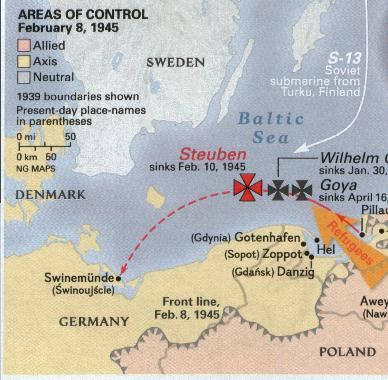Index Gustloff
Steuben
|
It took 20 minutes for the German liner Steuben to sink with 4,500 people after Russian torpedoes split its hull in 1945. It took 60 years to find the ship's remains in the Baltic Sea. So begins the article in the National Geographic of February 2005. Soviet Submarine, the S-13, commanded by Ivanovitch Marinesko. He was born a Ukrainian. He was stationed at Turku, Finland. A demanding and punctual commander at sea, ashore he loosened up, sometimes to the detriment of discipline and annoyed his commanders constantly. On Jan 30th 1945, he launched three torpedoes at the Wilhelm Gustloff carrying possibly as many as 10,000 refugees back to Germany from the port of Gdansk in Poland. This alone may have been the single most tragic loss of life of the whole war. In April the same year, the Goya was sunk by another Soviet submarine with the loss of between 6000 and 7000 people. These ships were being used for the evacuation of both solders and civilians.
On 9th February 1945 the 14,600-ton liner left port in Pillau with 2000
wounded, 230 nurses, 30 doctors and about 1000 civil refugees. Only 300 soldiers
were saved. 3600 people died.
On February 9th, just after 2200 hrs, Moscow time, Marinesko saw the glow from the smokestacks of Steuben's escorts. He thought they were escorting a cruiser when he misheard the sounds of the Steuben's propellers. He began to follow his target. He had to crash dive when one of the escorting ships suddenly turned and raced directly for the submarine. An hour later he was able to resume following the ships. At 0250 hrs he order Vladimir Kurochkin to launch two torpedoes from the aft tubes. A survivor remarked that he had survived the sinking of one ship so he knew when he heard the terrible noise what had happened. The torpedo had hit the bow, killing most of the crew members in that region. "I ran towards the deck. On my way I heard shots reverberating through the corridors. Soldiers, wounded soldiers, were committing suicide. When he arrived on deck, the ship was already listing. Many people were panicking and jumping directly into the sea, it was freezing, they did not last long. I finally got into a raft. Another, a wounded solider, crawled up the stairways after hearing the shots. He reached the deck and crawled to the rails when a large wave swept him into the sea. Luck was on his side and an empty raft floated over to him. Others joined him.
Two young ladies were told by a soldier that there was nothing to panic about, two ships had collided. They did not believe him and also made their way to the decks on the already listing ship. The ship listed badly and she clung to a ladder before a soldier hoisted her up but "nobody below me followed me out". The water reached up to them and took them off the sinking bows. One of them, Marti Gleich, vanished and was never seen again. In less than 20 minutes Steuben vanished beneath the waves. Gerhard Dopke recalled, ' I started to crawl up steep stairs, both hands bandaged, but people forced me down again, this happened twice. I could hear shots below me from the suicides. As I reached the ships rail, she was already on her way down, a huge wave swept me from the ship. Then a miracle, an empty raft floated by me. People clambered on top of me and my face was only just above the water. I then lost consciousness for a few hours. '
The submarine commander returned to Turku and was sure he would receive the Hero of the Soviet Union for sinking the two ships. Despite his achievements his commanders had not forgotten his earlier subordinations and he received the less prestigious Combat Order of The Red Banner. He survived the war, was demoted two ranks and given command of a minesweeper. He refused and was sacked from the Soviet Navy. Accused of theft at a Blood Transfusion Institute, he served 3 years, but served 18 months before his release. He died in Leningrad, of cancer, in 1963. Mikhail Gorbachev awarded him the Hero of The Soviet Union just before the fall of the Soviet Union. He is buried in St Petersburg in a granite tomb with gold letters. On top, his bust.
Captain Alexander Marinesko was a loner, a renegade, who disliked authority and frequently became insubordinate to his superiors. After WW2 he was dismissed in spite of the fact he held the Combat Order of the Red Banner. He found work at a Blood Transfusion Clinic but quarrelled with staff who later accused him of theft. He served 18 months in a Labour Camp. He died of cancer in 1963. In 1990 President Gorbachev ensured his legacy with the posthumous award of the Hero of the Soviet Union. Commanding the S-13, armed with 533 calibre torpedoes, his record of 40,000 on a single patrol will never, ever, be beaten. He was born in the Ukraine, he is survived by his daughter Tatiana who lives in Kronstadt. Marcin Jamkowski wrote an article on the Steuben in the Feb 2005 edition of the National Geographic. This was not used in my research as I only found the article in 2010.
http://sabaoth.infoserve.pl/danzig-online/gustloff/steubene.html Source of one or two images |
